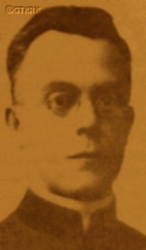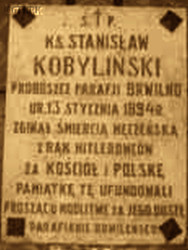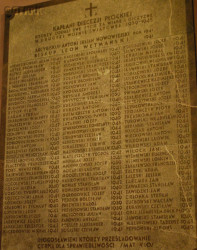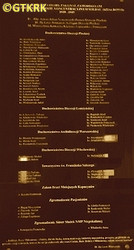Roman Catholic
St Sigismund parish
05-507 Słomczyn
85 Wiślana Str.
Konstancin deanery
Warsaw archdiocese, Poland
full list:
displayClick to display full list

searchClick to search full list by categories
wyświetlKliknij by wyświetlić pełną listę po polsku

szukajKliknij by przeszukać listę wg kategorii po polsku

Martyrology of the clergy — Poland
XX century (1914 – 1989)
personal data
surname
KOBYLIŃSKI
forename(s)
Stanislav (pl. Stanisław)
function
diocesan priest
creed
Latin (Roman Catholic) Church RCmore on
en.wikipedia.org
[access: 2014.09.21]
diocese / province
Płock diocesemore on
en.wikipedia.org
[access: 2013.05.19]
date and place
of death
08.12.1941

KL Soldauconcentration camp
today: Działdowo, Działdowo urban gm., Działdowo pov., Warmia‐Masuria voiv., Poland
more on
en.wikipedia.org
[access: 2018.09.02]
alt. dates and places
of death
Białucki forestn. Białut
today: Iłowo‐Osada gm., Działdowo pov., Warmia‐Masuria voiv., Poland
more on
en.wikipedia.org
[access: 2021.09.02]
details of death
In 08.1915, during World War I, after the Russian defeat in the Battle of Gorlice in 05.1915, as a result of the German and Austro–Hungarian pressure, withdrew along with millions of officials and military of the Russian partitioning power into the interior of Russia, to the east (so‐called bezhenstvo) . There, among others, was employed as a purser in a military hospital and auditor of the District Board of the All–Russian Land Union in Orsha.
To his homeland returned in 07.1918, after the Bolshevik revolution in Russia and the German–Austro–Hungarian–Russian separatist peace treaty in Brest on 03.03.1918.
After German and Russian invasion of Poland in 09.1939 and start of the World War II, after start of German occupation, arrested by the Germans on 06.03.1941 ‐ the son of a German colonist from a nearby village came to his parish asking him to go with him to another nearby village, Biała, „for a study”.
There ‐ along with two other priests, Fr John Krogulecki, and Fr Peter Alexander Trojańczyk — apprehended by the Germans.
Transported to Płock prison and then to KL Soldau concentration camp where perished.
alt. details of death
Murdered — during „an attempt to eliminate the typhus epidemic”. The selected method of this „attempt” was the physical extermination of all prisoners of the KL Soldau concentration camp. The victims were prob. shot in the Białucki forest (about 10 km east of the camp) and buried in mass graves (according to other sources, the victims were buried in the Jewish cemetery or in the municipal forest in Działdowo).
cause of death
extermination
perpetrators
Germans
sites and events
KL SoldauClick to display the description, Białucki forestClick to display the description, PłockClick to display the description, 02‐03.1941 arrests (Zichenau region)Click to display the description, Regierungsbezirk ZichenauClick to display the description, Ribbentrop‐MolotovClick to display the description, Pius XI's encyclicalsClick to display the description
date and place
of birth
13.01.1894

Maków Mazowieckitoday: Maków Mazowiecki urban gm., Maków Mazowiecki pov., Masovia voiv., Poland
more on
en.wikipedia.org
[access: 2021.08.06]
presbyter (holy orders)
ordination
21.12.1929

Płocktoday: Płock city pov., Masovia voiv., Poland
more on
en.wikipedia.org
[access: 2021.12.18]
Assumption of the Blessed Virgin Mary RC cathedral churchmore on
en.wikipedia.org
[access: 2025.03.14]
positions held
1938 – 1941
parish priest — Brwilnotoday: Stara Biała gm., Płock pov., Masovia voiv., Poland
more on
en.wikipedia.org
[access: 2021.12.18] ⋄ St Andrew the Apostle RC parish ⋄ Płocktoday: Płock city pov., Masovia voiv., Poland
more on
en.wikipedia.org
[access: 2021.12.18] RC deanery
1934 – 1938
vicar — Ciechanówtoday: Ciechanów urban gm., Ciechanów pov., Masovia voiv., Poland
more on
en.wikipedia.org
[access: 2021.12.18] ⋄ Nativity of the Blessed Virgin Mary RC church ⋄ St Joseph RC parish ⋄ Ciechanówtoday: Ciechanów urban gm., Ciechanów pov., Masovia voiv., Poland
more on
en.wikipedia.org
[access: 2021.12.18] RC deanery
1931 – 1934
vicar — Skrwilnotoday: Skrwilno gm., Rypin pov., Kuyavia‐Pomerania voiv., Poland
more on
en.wikipedia.org
[access: 2021.12.18] ⋄ St Anne RC parish ⋄ Rypintoday: Rypin gm., Rypin pov., Kuyavia‐Pomerania voiv., Poland
more on
en.wikipedia.org
[access: 2021.12.18] RC deanery
1930 – 1931
prefect — Gąbintoday: Gąbin gm., Płock pov., Masovia voiv., Poland
more on
en.wikipedia.org
[access: 2021.12.18] ⋄ primary schools ⋄ St Nicholas the Bishop and Confessor RC parish ⋄ Gąbintoday: Gąbin gm., Płock pov., Masovia voiv., Poland
more on
en.wikipedia.org
[access: 2021.12.18] RC deanery
1930
vicar — Lekowotoday: Regimin gm., Ciechanów pov., Masovia voiv., Poland
more on
en.wikipedia.org
[access: 2021.12.18] ⋄ St Stanislav the Bishop and Martyr RC parish ⋄ Ciechanówtoday: Ciechanów urban gm., Ciechanów pov., Masovia voiv., Poland
more on
en.wikipedia.org
[access: 2021.12.18] RC deanery
1925 – 1929
student — Płocktoday: Płock city pov., Masovia voiv., Poland
more on
en.wikipedia.org
[access: 2021.12.18] ⋄ philosophy and theology, Theological Seminary
till 1925
employee — Poznańtoday: Poznań city pov., Greater Poland voiv., Poland
more on
en.wikipedia.org
[access: 2021.07.18] ⋄ H. Cegielski Joint Stock Society company
from c. 1919
student — Poznańtoday: Poznań city pov., Greater Poland voiv., Poland
more on
en.wikipedia.org
[access: 2021.07.18] ⋄ law, Poznań University [i.e. Adam Mickiewicz University (from 1955) / Poznań University (1945‐1955, 1920‐1939) / Piast University (1919‐1920) / Polish University (1918‐1919) / Royal Academy (1903‐1918)]
others related
in death
ARENDZIKOWSKIClick to display biography Adam, BROMIRSKIClick to display biography Vladislav John, BROSZKIEWICZClick to display biography Alexander Casimir, KROGULECKIClick to display biography John Jerome, PRZYGÓDZKIClick to display biography Julian Ceslav, SKIERKOWSKIClick to display biography Vladislav, TROJAŃCZYKClick to display biography Peter Alexander, WILKOWSKIClick to display biography Adam, ZALEWSKIClick to display biography Julian, ZAREMBAClick to display biography John, CABANClick to display biography Steven Ceslav, GIERGIELEWICZClick to display biography Francis, GOSZCZYŃSKIClick to display biography Adam Lucian, KLENIEWSKIClick to display biography Eugene Paul, KOLATORClick to display biography Bronislav, KOPERClick to display biography Bronislav, KOZŁOWSKIClick to display biography John, KUŚMIERCZYKClick to display biography Anthony, NASIŁOWSKIClick to display biography Stanislav, OGRODOWICZClick to display biography Joseph, ROESLERClick to display biography Alexander Nicodemus, ROGALSKIClick to display biography Ceslav, SALWOWSKIClick to display biography Joseph, SOBOCIŃSKIClick to display biography Joseph, STROJNOWSKIClick to display biography Joseph Valentine, SZYDŁOWSKIClick to display biography John, WALCZAKClick to display biography Anthony, WETMAŃSKIClick to display biography Leo, WILOCHClick to display biography John Louis, WIŚNIEWSKIClick to display biography Eugene, ZALESKIClick to display biography Adam, ZAWIDZKIClick to display biography John
sites and events
descriptions
KL Soldau: German Germ. Konzentrationslager (Eng. concentration camp) KL Soldau (in modern Działdowo city) — since the pre‐war Polish Działdowo county was incorporated into Germ. Regierungsbezirk Allenstein (Eng. Olsztyn regency) the camp was located in occupied territories where general German law was in force, i.e. in Germany proper — was founded in 09.1939, when in former barracks of 32nd Infantry Regiment of Polish Army Germans set up a temporary camp for POW captured during September 1939 campaign. In autumn 1939 was also used as police jail. In 1939‐1940 changed into Germ. Durchgangslager für polnische Zivilgefangene (Eng. Transit Camp for Polish Civilians), prior to transport to other concentration camps. In reality it was used then as a place of extermination of Polish intelligentsia within Germ. «Intelligenzaktion» genocidal program and extermination of sick and disabled within «Aktion T4» program. Next in 05.1940 the camp was changed again into Germ. Arbeitserziehungslager (Eng. Work Education Camp), and finally into penal comp for criminal and political prisoners, most of whom were sentenced to death. In 1939‐1941 Germans imprisoned, maltreated and tortured in KL Soldau hundreds of Polish priests and religious. Approx. 80 priests, religious and nuns perished. They were murdered in the camp itself, by a shot into a head, or in places of mass executions in nearby forests — Białuty forest, Malinowo forets, Komorniki. Dates and precise locations of these murders remain unknown. Altogether in KL Soldau approx. 15,000 prisoners were murdered, including thousands victims — patients of psychiatric institutions (within «Aktion T4» plan). (more on: mazowsze.hist.plClick to attempt to display webpage
[access: 2013.08.17], en.wikipedia.orgClick to attempt to display webpage
[access: 2018.09.02])
Białucki forest: Execution site of prisoners held in the KL Soldau concentration camp, by the village Iłowo Osada. Among others Passionists from Przasnysz and c. 58 priests from Płock region were probably murdered there. Altogether in 1941‐1945 Germans murdered there c. 12,000 KL Soldau prisoners. The victims were buried in 3 mass graves in the 200 ha forest. To cover up murders a pine trees were planted on the graves. In 1944 during „Sonderaktion 1005” (Eng. „Special action 1005”) — also „Enterdungsaktion” (Eng. „Exhumation Action”) Germanunits of Germ. Sicherheitsdienst des Reichsführers‐SS (Eng. Reichsführer‐SS Security Services), i.e. SD, and uniform soldiers of Germ. Ordnungspolizei (Eng. Order Police), i.e. OrPo, dug out the bodies, burnt them, scattered the ashes and again planted pine trees. (more on: pl.wikipedia.orgClick to attempt to display webpage
[access: 2013.01.13], www.polskaniezwykla.plClick to attempt to display webpage
[access: 2015.05.09])
Płock: In its present location, the prison in Płock was built in 1803 by the Prussians (after the Third Partition of Poland, Płock was initially part of the Prussia). From 1815, it functioned as a Russian prison (among others, the November insurgents were detained there). During World War II, during the German occupation — Płock found itself in the so‐called Germ. Regierungsbezirk Zichenau (Eng. Ciechanów regency), part of the Germ. Provinz Ostpreußen (Eng. East Prussia province) — it was managed by the Germans. The jail ran by the German political police Gestapo was located in a different place — initially in the basement of the present town hall in Płock. From 1941 it was transferred — as an investigative prison — to a building at 1st of May Str., built in 1905. Many of the Polish prisoners were next transported to German concentration camps, mainly KL Soldau, where they perished. After the German defeat, this building was taken over by the Russians, and then by the Polish Commie‐Nazis in the service of the Russian KGB, and treacherous murders of former soldiers of the Polish Clandestine State were prob. carried out there. In 1991, the main prison was visited by Pope St John Paul II, who said to the inmates: „You are condemned, but not doomed”.
02‐03.1941 arrests (Zichenau region): In the night of 17/18.02.1941 and night of 06/07.03.1941 Germans arrested dozens of Catholic priests and nuns from Germ. Regierungsbezirk Zichenau (Eng. Ciechanów regency), a Polish occupied region directly incorporated by the Germans into Germ. Provinz Ostpreußen (Eng. East Prussia) province. All were transported, via Płock prison, to KL Soldau concentration camp. Among the arrested were two Catholic bishops of Płock diocese, Abp Nowowiejski and Bp Wetmański. Few priests were murdered in KL Soldau (including both bishops), more later on in other concentration camp, mainly in KL Dachau. Most of the nuns were subsequently released.
Regierungsbezirk Zichenau: After the Polish defeat in the 09.1939 campaign, which was the result of the Ribbentrop‐Molotov Pact and constituted the first stage of World War II, and the beginning of German occupation in part of Poland (in the other, eastern part of Poland, the Russian occupation began), the Germans divided the occupied Polish territory into five main regions (and a few smaller). The largest one was transformed into Germ. Generalgouvernement (Eng. General Governorate), intended exclusively for Poles and Jews and constituting part of the so‐called Germ. Großdeutschland (Eng. Greater Germany). From two separate new provinces were created. The two remaining were incorporated into existing German provinces. One of those was the Germ. Regierungsbezirk Zichenau (Eng. Ciechanów regency), created from part of the occupied Warsaw voivodeship, and incorporated into the Germ. Provinz Ostpreußen (Eng. East Prussia) — on the basis of the decree of the German leader Adolf Hitler of 08.10.1939 (formally in force from 26.10.1939) — in which the law of the German state was applicable. The main axis of the policy of the new regency, the territory of which the Germans recognized as the Germ. „Ursprünglich Deutsche” (Eng. „natively German”), despite the fact only 6% of its pre–war Polish part were Germans, was Germ. „Entpolonisierung” (Eng. „Depolonisation”), i.e. forced Germanization, and Germ. Zwangsarbeit (Eng. forced slave labor). Most of the Germ. Zivilarbeiter (Eng. civilian worker) slaved in the Germ. Provinz Ostpreußen. Some Poles— c. 25,000 — were deported to the Germ. Generalgouvernement; some were sent to concentration camps. Children could only learn in German. A policy of terror was pursued against the Polish population — 8 large prisons operated in a small area, Polish organizations and institutions were closed. The Polish press was liquidated. Of the 200 arrested Catholic priests from the Płock diocese, 110 were murdered. Most parishes were left without pastors — only a few priests per county were allowed to serve. Conducting services, sermons and confessions in Polish was prohibited. Churches were plundered and turned into warehouses. Catholic funerals with more than 10 people were prohibited. Crosses, roadside shrines, tombstones and cemeteries were destroyed. After the end of hostilities of World War II, the overseer of this province, the Germ. Reichsstatthalter (Eng. Reich Governor) and the Germ. Gauleiter (Eng. district head) of the German National Socialist Party, Erich Koch, initially went into hiding, then was captured and extradited to the Commie–Nazi republic of Poland prl, sentenced to death, but the sentence was not carried out and died in prison in 1986. The Germ. Regierungspräsidenten Zichenau (Eng. superpresident of the Ciechanów regency) hid better and his post‐war fate is still unknown. (more on: en.wikipedia.orgClick to attempt to display webpage
[access: 2024.06.24])
Ribbentrop‐Molotov: Genocidal Russian‐German alliance pact between Russian leader Joseph Stalin and German leader Adolf Hitler signed on 23.08.1939 in Moscow by respective foreign ministers, Mr. Vyacheslav Molotov for Russia and Joachim von Ribbentrop for Germany. The pact sanctioned and was the direct cause of joint Russian and German invasion of Poland and the outbreak of the World War II in 09.1939. In a political sense, the pact was an attempt to restore the status quo ante before 1914, with one exception, namely the „commercial” exchange of the so‐called „Kingdom of Poland”, which in 1914 was part of the Russian Empire, fore Eastern Galicia (today's western Ukraine), in 1914 belonging to the Austro‐Hungarian Empire. Galicia, including Lviv, was to be taken over by the Russians, the „Kingdom of Poland” — under the name of the General Governorate — Germany. The resultant „war was one of the greatest calamities and dramas of humanity in history, for two atheistic and anti‐Christian ideologies — national and international socialism — rejected God and His fifth Decalogue commandment: Thou shall not kill!” (Abp Stanislav Gądecki, 01.09.2019). The decisions taken — backed up by the betrayal of the formal allies of Poland, France and Germany, which on 12.09.1939, at a joint conference in Abbeville, decided not to provide aid to attacked Poland and not to take military action against Germany (a clear breach of treaty obligations with Poland) — were on 28.09.1939 slightly altered and made more precise when a treaty on „German‐Russian boundaries and friendship” was agreed by the same murderous signatories. One of its findings was establishment of spheres of influence in Central and Eastern Europe and in consequence IV partition of Poland. In one of its secret annexes agreed, that: „the Signatories will not tolerate on its respective territories any Polish propaganda that affects the territory of the other Side. On their respective territories they will suppress all such propaganda and inform each other of the measures taken to accomplish it”. The agreements resulted in a series of meeting between two genocidal organization representing both sides — German Gestapo and Russian NKVD when coordination of efforts to exterminate Polish intelligentsia and Polish leading classes (in Germany called «Intelligenzaktion», in Russia took the form of Katyń massacres) where discussed. Resulted in deaths of hundreds of thousands of Polish intelligentsia, including thousands of priests presented here, and tens of millions of ordinary people,. The results of this Russian‐German pact lasted till 1989 and are still in evidence even today. (more on: en.wikipedia.orgClick to attempt to display webpage
[access: 2015.09.30])
Pius XI's encyclicals: Facing the creation of two totalitarian systems in Europe, which seemed to compete with each other, though there were more similarities than contradictions between them, Pope Pius XI issued in 03.1937 (within 5 days) two encyclicals. In the „Mit brennender Sorge” (Eng. „With Burning Concern”) published on 14.03.1938, condemned the national socialism prevailing in Germany. The Pope wrote: „Whoever, following the old Germanic‐pre‐Christian beliefs, puts various impersonal fate in the place of a personal God, denies the wisdom of God and Providence […], whoever exalts earthly values: race or nation, or state, or state system, representatives of state power or other fundamental values of human society, […] and makes them the highest standard of all values, including religious ones, and idolizes them, this one […] is far from true faith in God and from a worldview corresponding to such faith”. On 19.03.1937, published „Divini Redemptoris” (Eng. „Divine Redeemer”), in which criticized Russian communism, dialectical materialism and the class struggle theory. The Pope wrote: „Communism deprives man of freedom, and therefore the spiritual basis of all life norms. It deprives the human person of all his dignity and any moral support with which he could resist the onslaught of blind passions […] This is the new gospel that Bolshevik and godless communism preaches as a message of salvation and redemption of humanity”… Pius XI demanded that the established human law be subjected to the natural law of God , recommended the implementation of the ideal of a Christian state and society, and called on Catholics to resist. Two years later, National Socialist Germany and Communist Russia came together and started World War II. (more on: www.vatican.vaClick to attempt to display webpage
[access: 2023.05.28], www.vatican.vaClick to attempt to display webpage
[access: 2023.05.28])
sources
personal:
mazowsze.hist.plClick to attempt to display webpage
[access: 2012.11.23], www.diecezjaplocka.plClick to attempt to display webpage
[access: 2013.01.13]
bibliographical:
„Płock diocese clergy martyrology during II World War 1939‐1945”, Fr Nicholas Marian Grzybowski, Włocławek–Płock 2002
original images:
www.european-wooden-religious-heritage.orgClick to attempt to display webpage
[access: 2021.12.19], radioolsztyn.plClick to attempt to display webpage
[access: 2021.08.06]
LETTER to CUSTODIAN/ADMINISTRATOR
If you have an Email client on your communicator/computer — such as Mozilla Thunderbird, Windows Mail or Microsoft Outlook, described at WikipediaPatrz:
en.wikipedia.org, among others — try the link below, please:
LETTER to CUSTODIAN/ADMINISTRATORClick and try to call your own Email client
If however you do not run such a client or the above link is not active please send an email to the Custodian/Administrator using your account — in your customary email/correspondence engine — at the following address:

giving the following as the subject:
MARTYROLOGY: KOBYLIŃSKI Stanislav
To return to the biography press below:
 Click to return to biography
Click to return to biography











